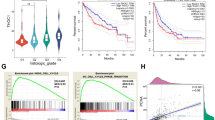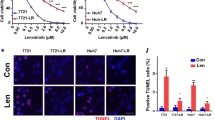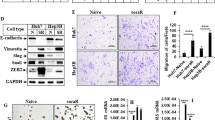Abstract
Objective
Hepatocellular carcinoma (HCC) is the third leading cause of cancer-associated death worldwide. As a first-line drug for advanced HCC treatment, lenvatinib faces a significant hurdle due to the development of both intrinsic and acquired resistance among patients, and the underlying mechanism remains largely unknown. The present study aims to identify the pivotal gene responsible for lenvatinib resistance in HCC, explore the potential molecular mechanism, and propose combinatorial therapeutic targets for HCC management.
Methods
Cell viability and colony formation assays were conducted to evaluate the sensitivity of cells to lenvatinib and dicoumarol. RNA-Seq was used to determine the differences in transcriptome between parental cells and lenvatinib-resistant (LR) cells. The upregulated genes were analyzed by GO and KEGG analyses. Then, qPCR and Western blotting were employed to determine the relative gene expression levels. Afterwards, the intracellular reactive oxygen species (ROS) and apoptosis were detected by flow cytometry.
Results
PLC-LR and Hep3B-LR were established. There was a total of 116 significantly upregulated genes common to both LR cell lines. The GO and KEGG analyses indicated that these genes were involved in oxidoreductase and dehydrogenase activities, and reactive oxygen species pathways. Notably, NAD(P)H:quinone oxidoreductase 1 (NQO1) was highly expressed in LR cells, and was involved in the lenvatinib resistance. The high expression of NQO1 decreased the production of ROS induced by lenvatinib, and subsequently suppressed the apoptosis. The combination of lenvatinib and NQO1 inhibitor, dicoumarol, reversed the resistance of LR cells.
Conclusion
The high NQO1 expression in HCC cells impedes the lenvatinib-induced apoptosis by regulating the ROS levels, thereby promoting lenvatinib resistance in HCC cells.
Similar content being viewed by others
References
Sung H, Ferlay J, Siegel RL, et al. Global Cancer Statistics 2020: GLOBOCAN Estimates of Incidence and Mortality Worldwide for 36 Cancers in 185 Countries. CA Cancer J Clin, 2021,71(3):209–249
Yang JD, Hainaut P, Gores GJ, et al. A global view of hepatocellular carcinoma: trends, risk, prevention and management. Nat Rev Gastroenterol Hepatol, 2019,16(10):589–604
Llovet JM, Kelley RK, Villanueva A, et al. Hepatocellular carcinoma. Nat Rev Dis Primers, 2021,7(1):6
Villanueva A. Hepatocellular Carcinoma. N Engl J Med, 2019,380(15):1450–1462
Vogel A, Meyer T, Sapisochin G, et al. Hepatocellular carcinoma. Lancet, 2022,400(10360):1345–1362
Zhao Y, Zhang YN, Wang KT, et al. Lenvatinib for hepatocellular carcinoma: From preclinical mechanisms to anti-cancer therapy. Biochim Biophys Acta Rev Cancer, 2020,1874(1):188391
Kudo M, Finn RS, Qin S, et al. Lenvatinib versus sorafenib in first-line treatment of patients with unresectable hepatocellular carcinoma: a randomised phase 3 non-inferiority trial. Lancet, 2018,391(10126):1163–1173
Llovet JM, Montal R, Sia D, et al. Molecular therapies and precision medicine for hepatocellular carcinoma. Nat Rev Clin Oncol, 2018,15(10):599–616
Huang A, Yang XR, Chung WY, et al. Targeted therapy for hepatocellular carcinoma. Signal Transduct Target Ther, 2020,5(1):146
Fisher R, Pusztai L, Swanton C. Cancer heterogeneity: implications for targeted therapeutics. Br J Cancer, 2013,108(3):479–485
McGranahan N, Swanton C. Clonal Heterogeneity and Tumor Evolution: Past, Present, and the Future. Cell, 2017,168(4):613–628
Losic B, Craig AJ, Villacorta-Martin C, et al. Intratumoral heterogeneity and clonal evolution in liver cancer. Nat Commun, 2020,11(1):291
Zhang K, Chen D, Ma K, et al. NAD(P)H:Quinone Oxidoreductase 1 (NQO1) as a Therapeutic and Diagnostic Target in Cancer. J Med Chem, 2018,61 (16):6983–7003
Li WY, Zhou HZ, Chen Y, et al. NAD(P)H: Quinone oxidoreductase 1 overexpression in hepatocellular carcinoma potentiates apoptosis evasion through regulating stabilization of X-linked inhibitor of apoptosis protein. Cancer Lett, 2019,451:156–167
Lin L, Sun J, Tan Y, et al. Prognostic implication of NQO1 overexpression in hepatocellular carcinoma. Hum Pathol, 2017,69:31–37
Tan W, Zhang K, Chen X, et al. GPX2 is a potential therapeutic target to induce cell apoptosis in lenvatinib against hepatocellular carcinoma. J Adv Res, 2023,44:173–183
Redza-Dutordoir M, Averill-Bates DA. Activation of apoptosis signalling pathways by reactive oxygen species. Biochim Biophys Acta, 2016,1863(12):2977–2992
Cui Q, Wang J-Q, Assaraf YG, et al. Modulating ROS to overcome multidrug resistance in cancer. Drug Resist Updat, 2018,41:1–25
Calabrese EJ, Bachmann KA, Bailer AJ, et al. Biological stress response terminology: Integrating the concepts of adaptive response and preconditioning stress within a hormetic dose-response framework. Toxicol Appl Pharmacol, 2007,222(1):122–128
Calabrese EJ, Mattson MP. Hormesis provides a generalized quantitative estimate of biological plasticity. J Cell Commun Signal, 2011,5(1):25–38
Calabrese EJ, Baldwin LA. Inorganics and hormesis. Crit Rev Toxicol, 2003,33(3–4):215–304
Dimri M, Humphries A, Laknaur A, et al. NAD(P)H Quinone Dehydrogenase 1 Ablation Inhibits Activation of the Phosphoinositide 3-Kinase/Akt Serine/Threonine Kinase and Mitogen-Activated Protein Kinase/Extracellular Signal-Regulated Kinase Pathways and Blocks Metabolic Adaptation in Hepatocellular Carcinoma. Hepatology, 2020,71(2):549–568
Zhou HZ, Zeng HQ, Yuan D, et al. NQO1 potentiates apoptosis evasion and upregulates XIAP via inhibiting proteasome-mediated degradation SIRT6 in hepatocellular carcinoma. Cell Commun Signal, 2019,17(1):168
Zhu H, Li Y. NAD(P)H: quinone oxidoreductase 1 and its potential protective role in cardiovascular diseases and related conditions. Cardiovasc Toxicol, 2012,12(1):39–45
Dinkova-Kostova AT, Talalay P. NAD(P)H:quinone acceptor oxidoreductase 1 (NQO1), a multifunctional antioxidant enzyme and exceptionally versatile cytoprotector. Arch Biochem Biophys, 2010,501(1):116–123
Siegel D, Gustafson DL, Dehn DL, et al. NAD(P) H:quinone oxidoreductase 1: role as a superoxide scavenger. Mol Pharmacol, 2004,65(5):1238–1247
Ross D, Siegel D. The diverse functionality of NQOl and its roles in redox control. Redox Biol, 2021,41:101950
Silva VLM, Silva-Reis R, Moreira-Pais A, et al. Dicoumarol: from chemistry to antitumor benefits. Chin Med, 2022,17(1):145
Sun C, Zhao W, Wang X, et al. A pharmacological review of dicoumarol: An old natural anticoagulant agent. Pharmacol Res, 2020,160:105193
Author information
Authors and Affiliations
Corresponding authors
Ethics declarations
All authors declare that they have no conflicts of interest.
Additional information
This work was supported by the Global Select Project (No. DJK-LX-2022001) of the Institute of Health and Medicine, Hefei Comprehensive National Science Center.
Supplementary data
Rights and permissions
About this article
Cite this article
Xue, W., Wang, T., Tian, Wj. et al. NQO1 Mediates Lenvatinib Resistance by Regulating ROS-induced Apoptosis in Hepatocellular Carcinoma. CURR MED SCI 44, 168–179 (2024). https://doi.org/10.1007/s11596-023-2804-8
Received:
Accepted:
Published:
Issue Date:
DOI: https://doi.org/10.1007/s11596-023-2804-8




